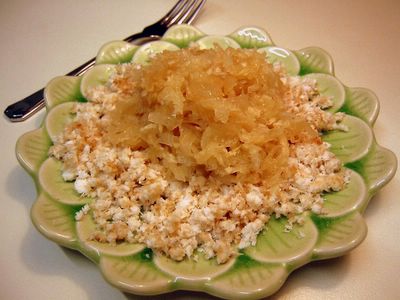The start of the rainy season in the Philippines (around June) usually coincide with the start of school. So the beginning of each bring back jaunted memories of smell of new pencils and erasers (rubber), smell of the plasticky-rubbery new umbrellas, bags and shoes, wet grass, newly wet earth, cool humid afternoons.
In a way, the rains are welcome respite from the intense heat and humidity of the preceding March-April. Though at the back of the mind is that wariness of the typhoons that are sure to come anytime to wreak havoc on people's lives and properties. For kids, typhoons are greeted with joy - school's closed, no classes! They bathe in the rain, some even in flood waters (not safe). But for me it comes with that snug feeling of warmth with all the family forced by the weather to be inside the house. My grandparent's house in Cavite where I grew up had those sliding capiz windows. They’re not water or windproof so come typhoons, we grandkids with our aunts race around the house stuffing edges and joints of windows with rags to prevent the rainwater from coming in. While my lolo (grandpa) goes out with these big abaca ropes to tie down the haligi (pillars) of the house and other trees around their yard.
After all the chores are done, since there was usually no electricity (so no TV to watch), my aunts would take out playing cards, sungka, checker boards, chess boards, etc. to keep us occupied. It was great fun really with us learning solitaires, pekwa, pares-pares, 21, and other card games. When it gets a bit dark, someone will regale us with ghost stories or listen to some scary drama shows on the radio. This will cause us kids to all stick together no matter where one goes - even in the toilet! Hahaha. ;)

As for the food, since there was no market, all our food are simple and lots of times comes from the 'victims' of the typhoon. So we often had the crops of those uprooted and damaged by the wind - kamote (sweet potatoes), saba banana, butuhan banana, balinghoy (kamoteng kahoy, cassava), kangkong (tung choi), talbos ng kamote (sweet potato tops), etc. These are cooked simply - meaning boiled or steamed - then eaten hot. Sometimes when the storm lasts for several days and we've had enough of boiled this and boiled that. My grandma would grate some balinghoy and steam it then serve with freshly grated coconut sprinkled with sugar. We call this 'kalangkang'. The combination of the soft, slightly gelatinous cassava and sweet grated coconut is simply divine! Sometimes the simple things in life are the best.

Kalangkang
finely grated cassava
freshly grated coconut
sugar (brown or white)
- (It's best to grate the cassava finely to have shorter cooking time.) Put the grated cassava on a very lightly greased bowl or plate.
- Place bowl in a steamer and cook on high steam for about 30 minutes or until cassava is translucent and soft.
- Serve hot or warm with grated coconut sprinkled with sugar.
Lasang Pinoy 2
thanks Ares..... I will try the kalangkang soon..
ReplyDelete